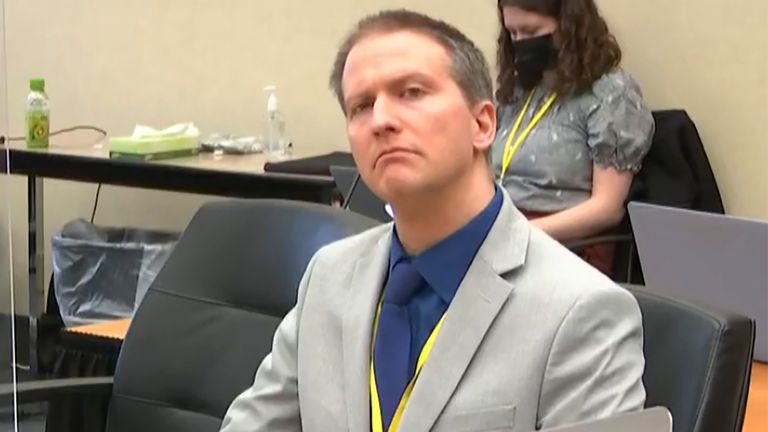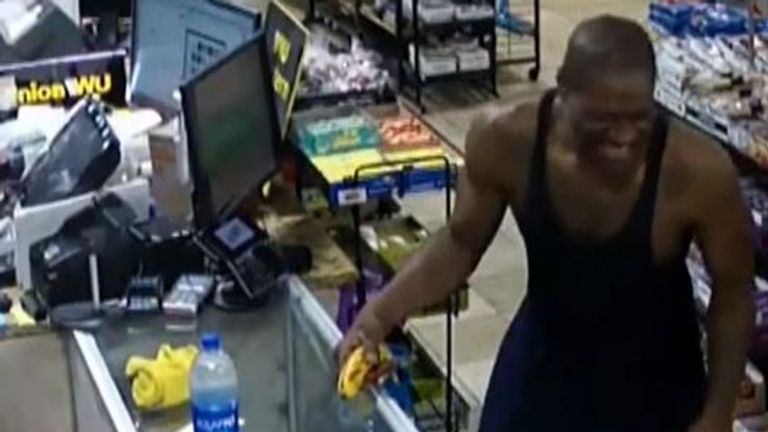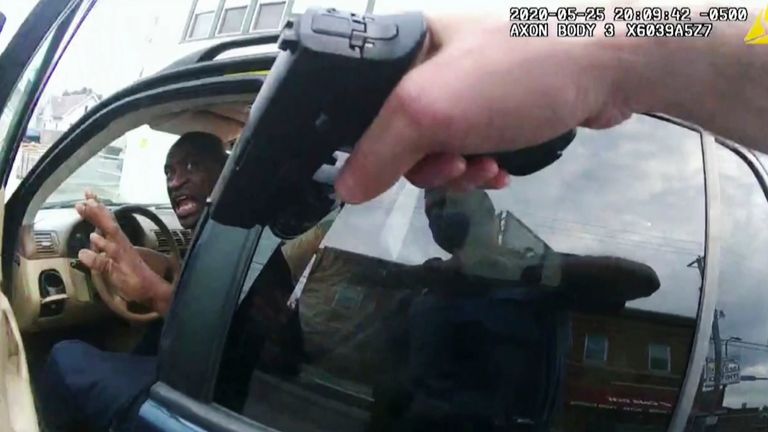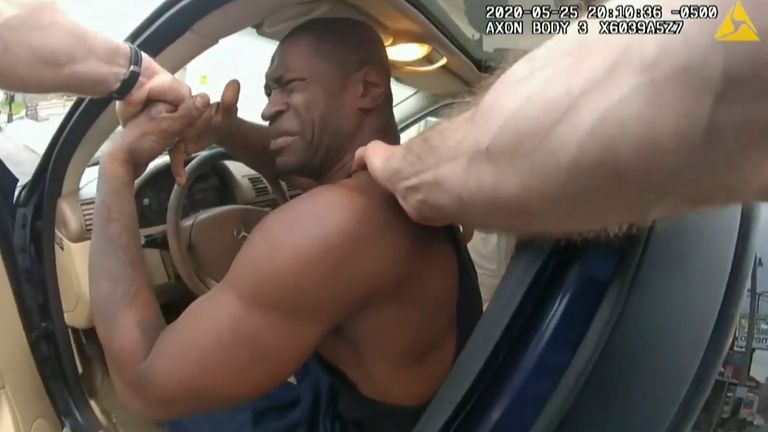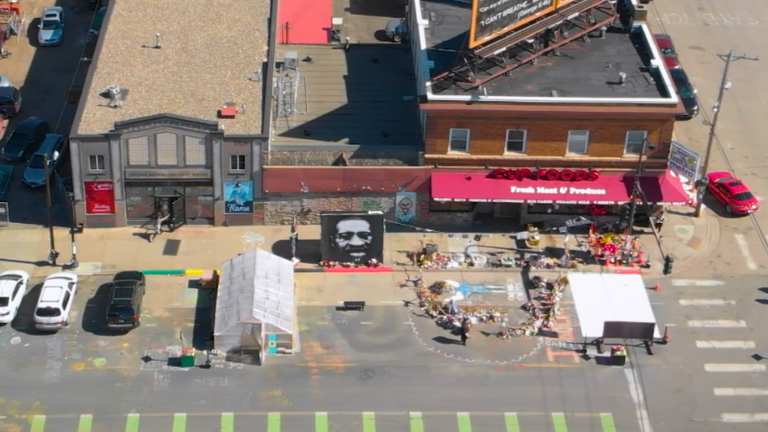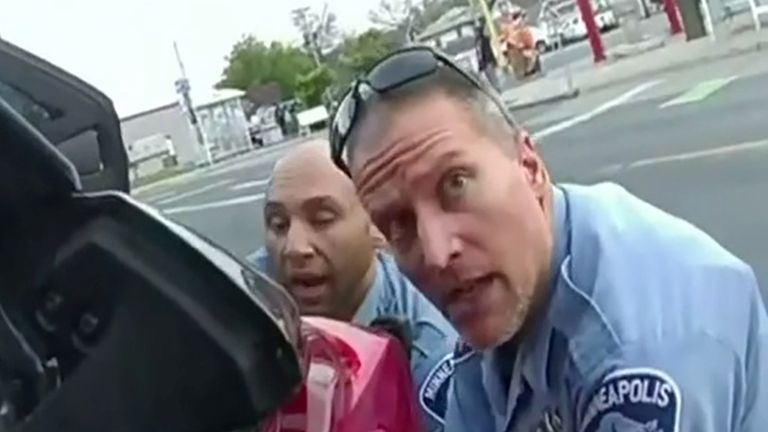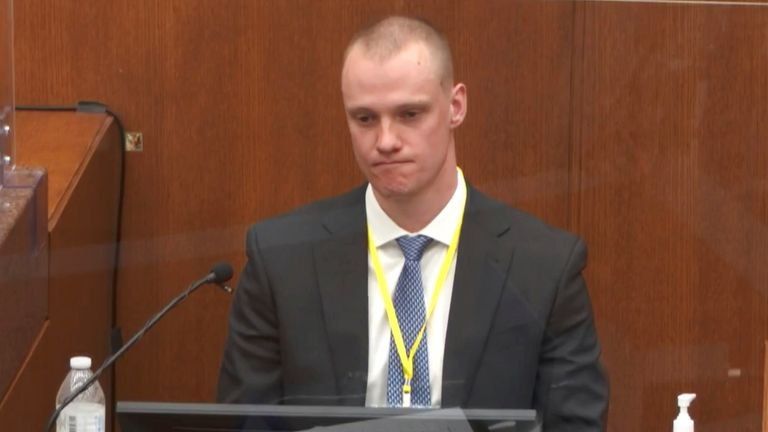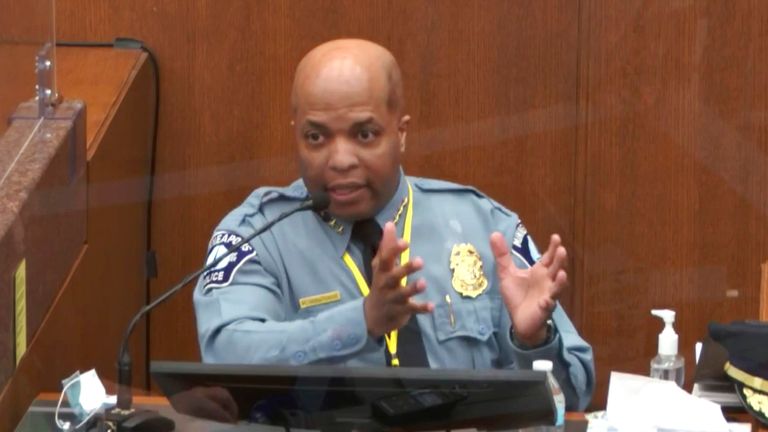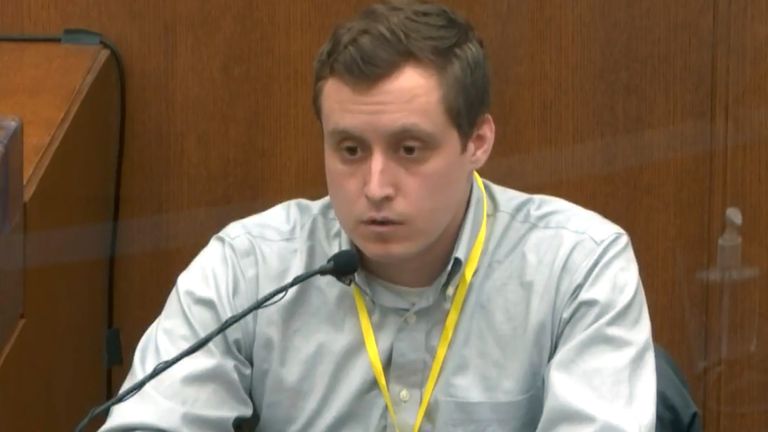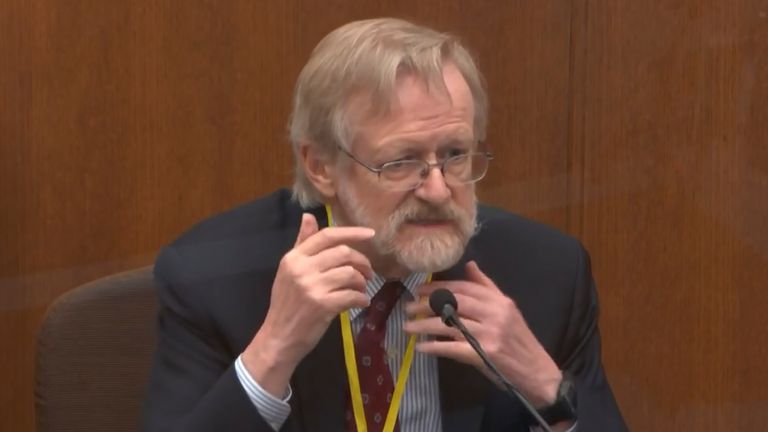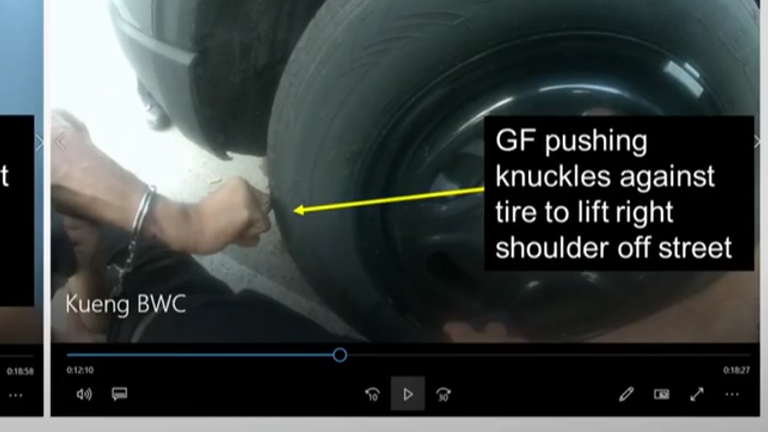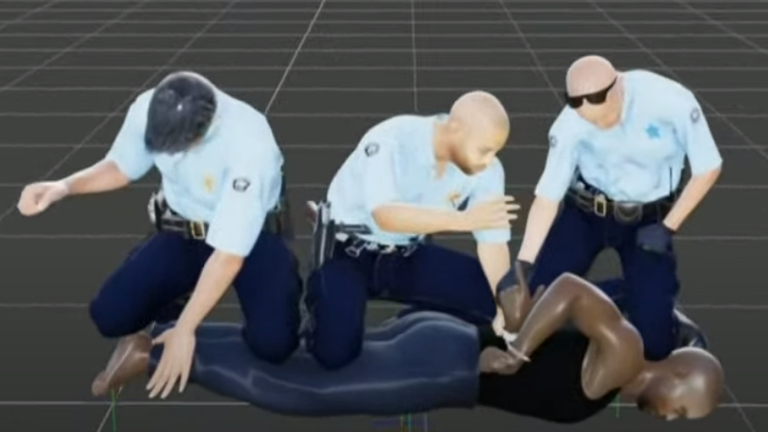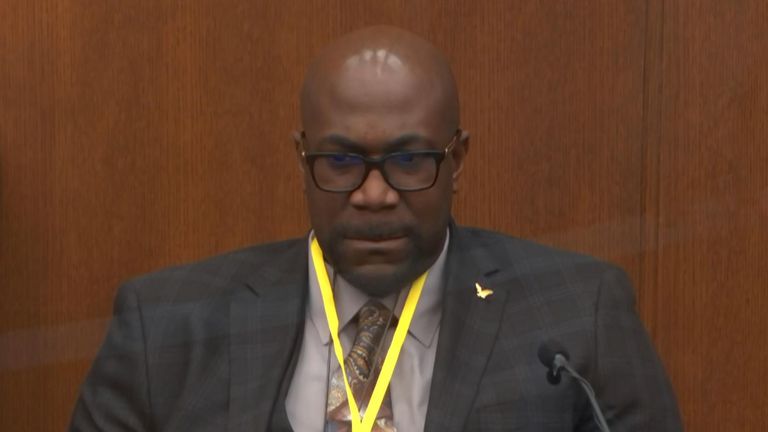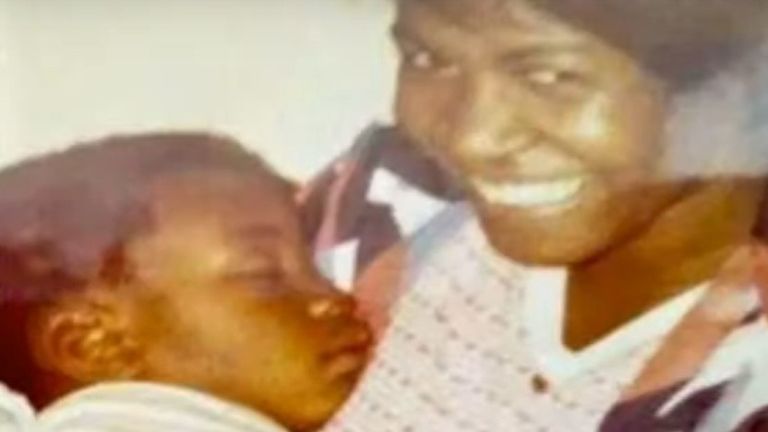Derek Chauvin guilty of murder: The story of the day George Floyd was killed – and the moments leading up to his death
The guilty verdict in the Derek Chauvin case came after a three-week trial during which the jury had to watch harrowing footage and hear distressing testimony of the last moments of George Floyd’s life.
It heard from numerous witnesses who described the ex-Minneapolis police officer’s behaviour as unreasonable and counter to what law enforcement would have been expected to do.
Chauvin was found guilty on all charges – second-degree murder, third-degree murder and second-degree manslaughter.
The court heard Mr Floyd – a 46-year-old black man – was arrested, refused to get into a patrol car because he suffered from claustrophobia and was then pinned down after police were called over his use of a fake $20 bill.
During the time he was held down, prosecution witnesses explained how footage from multiple angles showed the knee of Chauvin – a white officer – on Mr Floyd’s neck for nine minutes and 29 seconds.
And during the time Mr Floyd was held down, witnesses said officers refused to let first aiders check on his condition even though he had gone limp.
After video of eight minutes, 46 seconds of the incident went viral, there were worldwide protests, violence and a furious examination of racism and policing in the US and beyond – events that changed the way many people see racial issues.
Here is the story of that day in May that changed the world:
Warning: The following describes the final moments of George Floyd’s life which some may find upsetting
George Perry Floyd Jr had been living in Minneapolis for six years before he died.
Some time before 8pm on 25 May 2020, he visited Cup Foods, a store at the corner of the city’s East 38th Street and Chicago Avenue.
It was memorial day and he was with friends. He was known to have visited Cup Foods before and, this time, went to buy cigarettes, getting out of his SUV, which was parked up nearby.
He was served by Christopher Martin, who said Mr Floyd spoke slowly and sounded a bit like he was under the influence of drugs, but was friendly and talkative as he handed over a $20 bill.
Mr Martin immediately saw something suspicious about the note, but accepted it because, he told the court, he did not think Mr Floyd knew it was fake and thought he’d “be doing him a favour”.
But something afterwards made him tell his manager, and within seconds, he was sent out of the shop to ask Mr Floyd to come back inside.
Mr Floyd refused, prompting the manager to ask another employee to call police, who arrived on the scene soon after.
Body-worn video recorded by one of the attending officers showed how, as they arrived, one of the officers tapped on the window of Mr Floyd’s car, then, as he opened the door, pointed a pistol at him.
Mr Floyd reacted with shock, saying: “Please don’t shoot me, please, man. Please, man, I didn’t know,” and was quickly cuffed.
The prosecutor, Steve Schleicher, said Mr Floyd was completely compliant as he was asked to cross the street, provide his name and then go to a patrol car.
But, as they tried to put him into a patrol vehicle, he became agitated, telling them he was claustrophobic.
Mr Schleicher told the jury during his summing up: “He tried to explain himself to the officers that he had anxiety, that he had claustrophobia. He explained this over and over. They wanted him to get in the back of this little car and, you know, he just wasn’t able to bring himself to do it…
“So they don’t listen. They just shove him into the car, into that tiny back seat. You saw the look on his face… when he glanced over into that car, he looked like he’d seen a monster.”
An officer told him to “stop resisting”, to which Mr Floyd responded: “I’m not.”
In an attempt to reason with them, he said: “I’ma (going to) die, man… I’m not a bad guy.”
The altercation between officers and Mr Floyd quickly drew a crowd, many of whom started filming what was happening on their phones, concerned at what they were seeing.
Alisha Oyler, a cashier at a store across the road from Cup Foods, said she started recording because police were “always messing with people”.
Darnella Frazier, 18, recorded the footage that later went viral and provoked protests around the world.
The teenager said she had been walking to a convenience store with her nine-year-old cousin when she realised what was happening. She sent her cousin inside because she didn’t want her to see how “terrified, scared” Mr Floyd was, and how he was “begging for his life”.
She said that, because of the actions of police, Mr Floyd “was suffering, he was in pain”.
Another bystander, Charles McMillian, realising what was happening and worried for his safety, called out to Mr Floyd, saying: “You can’t win.”
Giving evidence during which he wept openly, Mr McMillian said Mr Floyd replied: “I’m not trying to win. I’m scared.”
Mr Schleicher told the court that when officers stopped trying to push him in the car, Mr Floyd said “thank you”, in gratitude for not making him get inside.
But seconds later he found himself on the floor and, despite what Mr Schleicher said was a lack of non-compliance, he was pressed to the ground, face down, with “a knee on the neck and a knee on the back and the defendant’s weight on Mr Floyd pushing down”.
The prosecutor said Chauvin’s knee then stayed on Mr Floyd’s neck for nine minutes and 29 seconds, 43 seconds longer than the previously often-quoted eight minutes, 46 seconds.
It was a move that proved fatal.
Several witnesses said Chauvin remained on top of him, despite numerous pleas from bystanders and from pleas from Mr Floyd himself.
He was heard on video footage calling out a number of times: “I love you mama” and “I can’t breathe”.
Mr Schleicher said his voice then slowed and faded.
An off-duty firefighter, Genevieve Hansen, told the court she saw what happened and, because she was medically trained, repeatedly asked to check Mr Floyd’s pulse.
She said she did so because she saw fluid coming from Mr Floyd’s body and, because of her training, knew that patients sometimes release their bladders when they are dying.
Her 911 call from the scene was played to the jury and she could be heard saying: “I literally watched police officers not take a pulse and not do anything to save a man.”
Ms Hansen said she was told by one of Chauvin’s police officer colleagues to stay away from Mr Floyd while he was being knelt on, saying he had told her: “If you are a Minneapolis firefighter, you would know better than to get involved.”
Police emergency call handler Jena Scurry, who was working at the time of Mr Floyd’s death, told the court she thought her screen had frozen when she saw how long police had been on top of Mr Floyd while watching live video footage from a police camera.
When the police shift supervisor David Pleoger arrived on the scene, Mr Floyd was not offering any resistance, but officers – who were trained to roll suspects on to their sides to help with their breathing – had not moved him.
Paramedic Seth Bravinder said, when he arrived, several officers were on top of Mr Floyd.
One of the earliest first responders on the scene, he added that when he examined Mr Floyd, the 46-year-old was “unresponsive”, his head was limp and he had flatlined, after a cardiac arrest.
Several police expert witnesses said the degree and type of force used by Chauvin was beyond that which should have been used in the situation.
Lieutenant Richard Zimmerman, the head of the Minneapolis homicide department, said the restraint should have stopped as soon as Mr Floyd was handcuffed and on the ground.
Medaria Arradondo, Minneapolis’ first black police chief, gave evidence against one of his own officers, saying “in no way, shape or form” did Chauvin’s actions follow the department’s policy or training and “certainly [were] not part of our ethics or our values”.
Lieutenant Johnny Mercil, a use-of-force instructor, said the neck restraint Chauvin used was not authorised.
It emerged during the trial that Chauvin took part in use-of-force training in 2018 and completed a 40-hour course on recognising people in a crisis in 2016.
Sergeant Ker Yang, the officer in charge of crisis-intervention training, said officers were taught to “slow things down and re-evaluate and reassess”.
Another use of force expert, Los Angeles Police Department sergeant Jody Stiger, testified that the degree of force applied to Mr Floyd’s neck area by Chauvin did not change throughout the entire nine minutes 29 seconds.
During Mr Stiger’s evidence, the jury was shown a series of five photos taken from footage of the arrest at various points, which the sergeant said showed Chauvin’s left knee on Mr Floyd’s neck, or neck area.
Because Chauvin refused to testify, the jury never received a full explanation about why he acted in the way he did.
The only hint they received was a comment heard by a bystander, who told the court Chauvin said, after an ambulance took away Mr Floyd: “We gotta control this guy ’cause he’s a sizable guy… and it looks like he’s probably on something.”
A series of doctors took the stand to say they believed that Mr Floyd died of asphyxia as a result of his neck and chest being compressed.
Among them, Dr Bradford Langenfeld, a senior resident on duty that night at Hennepin County Medical Centre, told the jury, based on the information he had, it was “more likely than the other possibilities” that Mr Floyd’s heart stopped because of asphyxia, or insufficient oxygen.
Dr Lindsey Thomas, a forensic pathologist, was adamant the death was not due to fentanyl, or methamphetamine, as the defence claimed, or due to Mr Floyd’s underlying health conditions.
She said: “There was nothing sudden about his death… Likewise, it was not the type of death that has been reported in fentanyl overdose, for example, where someone becomes very sleepy and then just sort of gradually, calmly, peacefully stops breathing.”
She said wounds seen on Mr Floyd’s body after his death were “consistent with what it looks like on the video, that he’s struggling to push himself into a position where he can breathe”.
Most significant however was evidence from Dr Martin Tobin, a lung and critical care specialist from Chicago, who said he watched footage of the arrest “hundreds of times” to help him work out where officers were positioned in relation to Mr Floyd when he was on the ground.
A photo shown to the jury showed the toe of Chauvin’s boot off the ground.
Dr Tobin said it meant all of the ex-officer’s 91.5lbs of body weight was “being directed down onto Mr Floyd’s neck” at this point in the arrest.
Mr Floyd was effectively sandwiched between the street and the officers, putting his left side “in a vice”, Dr Tobin said, and the effect on his left lung was deadly.
He said a photo from the footage that showed Mr Floyd pressing his fingers against the tyre of the police car showed how Mr Floyd had “used up his resources and he’s now literally trying to breathe with his fingers and knuckles”.
Dr Tobin also narrated video pinpointing what he said was the moment Mr Floyd died – indicated by a change in his face and a tell-tale leg kick – about five minutes after police began holding him down.
“You can see his eyes. He’s conscious, and then you see that he isn’t,” Dr Tobin said. “That’s the moment the life goes out of his body.”
Only one prosecution medical expert, Hennepin County medical examiner Dr Andrew Baker, expressed a different opinion, maintaining that police “subdual, restraint and neck compression” caused Mr Floyd’s heart to stop.
He admitted however he was no expert in breathing and said he would defer to the other experts.
As well as medical and police experts, the trial heard from those who knew Mr Floyd and could testify as to how he was missed.
Mr Floyd’s girlfriend Courteney Ross tearfully told the story of how they first met at a Salvation Army shelter in 2017.
The 45-year-old, who said she noticed him immediately because of his “great, deep Southern voice”, admitted how they both struggled with opioid addiction.
But she explained that it had only occurred because they suffered from pain.
“Both Floyd and I, our story, it’s a classic story of how many people get addicted to opioids,” she said. “We both suffered from chronic pain. Mine was in my neck and his was in his back.
“We both had prescriptions. But after prescriptions that were filled and we got addicted and tried really hard to break that addiction many times.”
And it was the stories told by his brother, Philonise, which underlined the hole left behind by his death.
The 39-year-old described growing up in a poor area of Houston, Texas, with his older brother George and their three siblings, before George moved away.
He said they used to play Nintendo, basketball and American football and said George deliberately threw the ball at different angles so Philonise would have to practice diving for it.
“I always thought my brother couldn’t throw. But he never intended to throw the ball to me,” he said, smiling.
He lovingly recalled how George used to make the best banana mayonnaise sandwiches and the way George used to mark his height on the wall as a boy because he wanted to grow taller.
He said George “was a big momma’s boy” and was inconsolable at her funeral in 2018, who everyone in the community knew as Miss Cissy.
Shown a photo of George and his late mother, he broke down, saying: “I miss them both.”
Source: Read Full Article
